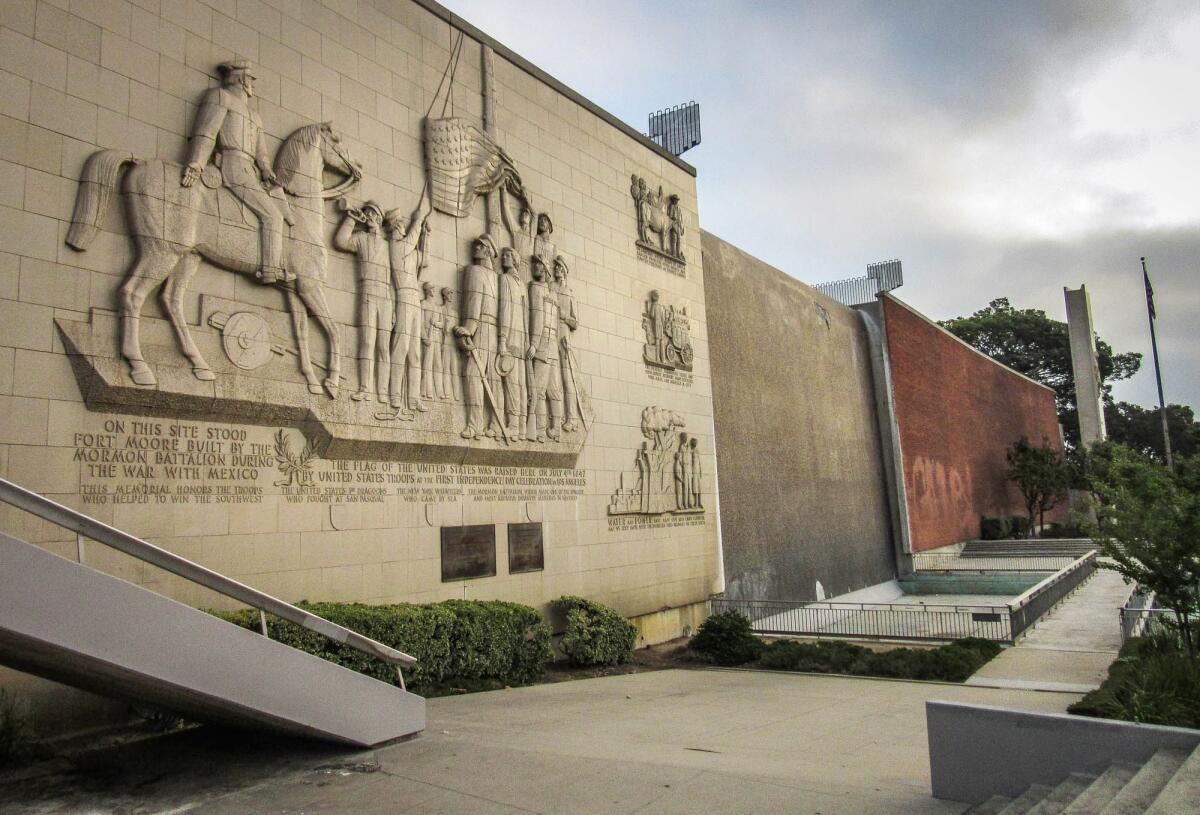A long-forgotten relic of old L.A. is restored and ready for its closeup

- Share via
The cascade that once gushed over the face of downtown’s Ft. Moore Hill, then went dry for decades, has been quietly test-run for a few weeks— its volume reduced to a film to conserve water.
Now, after a $6-million restoration, the Pioneer Memorial and its waterfall will be formally rededicated Wednesday. Sixty years to the day after it debuted on July 3, 1958, county officials and arts enthusiasts will gather at 10 a.m. below the 47-foot tall wall of water, brick and glazed terra cotta to mark the rebirth of what has been called “the most historically and geographically important monument that nobody knows about.”
The official rededication will be followed Thursday at 10 a.m. by a historical reenactment of L.A.’s first Independence Day which was celebrated at the site on what is now Hill Street between the 101 Freeway and Cesar Chavez Avenue.
Later, in conjunction with Veterans Day, civic and interfaith groups led by the Church of Jesus Christ of Latter-day Saints will put on a Nov. 9 pageant celebrating the service in Los Angeles of a battalion of Mormon volunteers depicted in the monument and the unification of Californios and Mexicanos under the U.S. flag.
The three ceremonies reflect different facets of the monument as a work of art, a memorial to the birth of Los Angeles as an American city and a tribute to the only religiously oriented military unit in U.S. Army history.
“The monument is about freedom and liberty and the pioneering spirit of Los Angeles,” said Marilyn Mills of the Ft. Moore Hill Memorial Committee that conducts annual Independence Day flag-raisings there.
Mills has written a history of the monument that will be placed in a time capsule inserted into its flagpole Wednesday.
“The county wanted to do their own reopening honoring the monument as a piece of civic art,” Mills said, explaining the back-to-back ceremonies.
Aside from the religious wrinkle, the events depicted in the monuments have also been clouded by reports that members of the battalion once fired down on the residents of the pueblo.
Mills said her research has disproved that legend.
“We actually found that there was Mexican military that was shooting at the Californios,” Mills said.
Clare Haggarty, deputy director of the Los Angeles County art collection until this spring, said the dedication date was set for the same reason as the original, to avoid the county holiday.
But she acknowledged the historical nuances.
“It’s a complicated project in this day and age,” Haggarty said. “What we were striving to do was be thoughtful about that, especially the time capsule.
“I opened a public call for submissions of items with the intention that it would reflect the cultural richness and the generational diversity of Los Angeles County,” she said.
Articles were collected from museums, cultural institutions, schools, even L.A. Metro, where she now works, Haggarty said.
The monument evolved partly for the need of a giant wall where the eastern flank of Ft. Moore hill was shaved away in the 1930s to make way for roads and buildings.
Pressed by the then socially-influential Daughters of Utah Pioneers, the L.A. County Board of Supervisors approved funding for the fountain and bas relief portraying the battalion’s 2,000-mile march to Los Angeles.
One of its vignettes also recognizes the Los Angeles Department of Water and Power, a sponsor of the memorial, with the inscription: “Water and power have made our arid land flourish.”
The fountain was turned off in 1977 during a drought. When rains finally returned, the waterfall’s mosaic tiles were falling off and its pumps had been vandalized.
The Pioneer Memorial was all but forgotten, popping up only occasionally in news reports on Fourth of July reenactments of the 1847 flag raising. The monument receded into a stretch of Ft. Moore Hill that became a desolate connection between Chinatown and Civic Center.
“It’s where Los Angeles really began, and it’s huge, and so many people don’t know it exists,” Haggarty said in early 2017 when the project got underway.
During the 2½-year restoration, a multistory modernist apartment complex was constructed opposite the 400-foot wall, giving the once-neglected monument a new sense of place.
More to Read
Sign up for Essential California
The most important California stories and recommendations in your inbox every morning.
You may occasionally receive promotional content from the Los Angeles Times.














